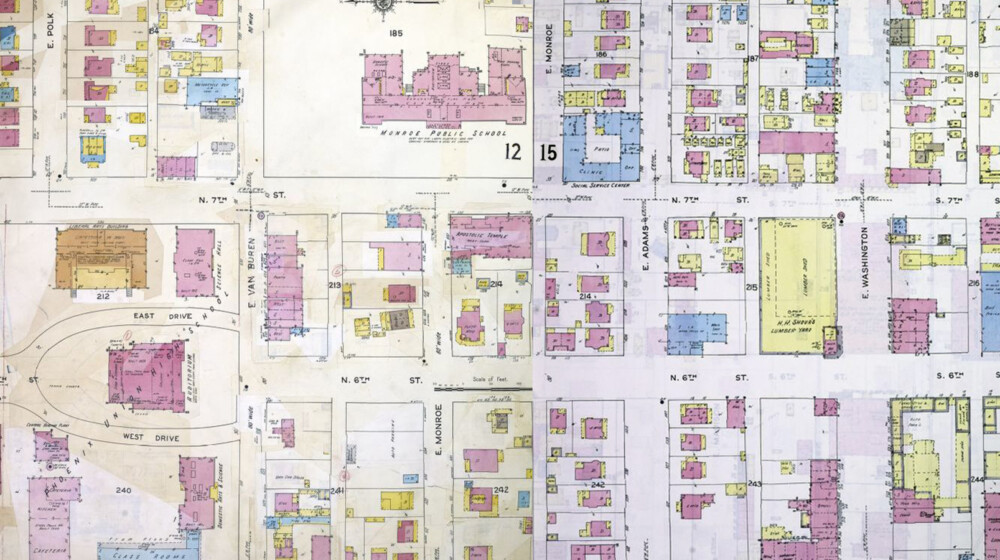“Representatives and direct Taxes shall be apportioned among the several States which may be included within this Union, according to their respective Numbers, which shall be determined by adding to the whole Number of free Persons, including those bound to Service for a Term of Years, and excluding Indians not taxed, three fifths of all other Persons. The actual Enumeration shall be made within three years after the first meeting of the Congress of the United States, and within every subsequent term of ten years, in such manner as they shall by law direct.” – Article 1, Section 2, of the US Constitution
The 1950 Census
For a printable version of this article, please click here.
Did you know…
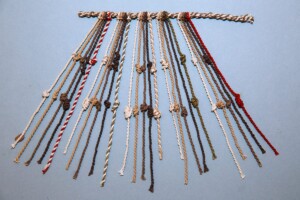
Ancient Incan khipu knots
Governments have been counting people and materials in censuses for thousands of years. The first known census in the world took place around 3800 BCE in the Babylonian Empire, and counted livestock, wool, butter, honey, milk, and vegetables. The oldest known surviving written census data is from the Chinese Han Dynasty (2 CE). Around 1400 years later, the Incan Empire recorded census data using knots on string. By the time Europe was colonizing much of the rest of the world, they used census data to keep track of and tax colonized populations.
The first census in the United States was taken beginning August 2, 1790 and was finished 18 months later. Rather than establishing a tax on US citizens, it instead assigned governmental funding, votes in the Electoral College, and Congressional seats. Arizona’s first census was taken in 1864 after it became an official US territory. It listed 4,187 inhabitants, not including Native Americans. Though the US census is decennial (taken every 10 years), in 2015, several Arizona cities completed a special census to update their booming population numbers. In 2020, records showed that the population of the entire state of Arizona grew 11.9% in the previous decade, reaching over 7 million people for the first time.
Census counts are snapshots in time, but are never 100% accurate. For one reason or another, people can be missed or overlooked, whether by accident (e.g. – if someone is away from their home during the count, for whatever reason) or deliberately (e.g. – “untaxed” Native Americans were purposefully excluded from the count in the US Constitution; enslaved African Americans were only included in the count as a whole – and only as 3/5 of a person – not as individuals in their own right; and many other minorities have been overlooked or their race/ethnicity ignored when counts were performed). Sometimes the enumerator’s handwriting is hard to decipher, and sometimes they spelled names wrong or recorded incorrect information. Sometimes other, outside influences can affect a census count (e.g. – when faced with overt, anti-immigrant legislation or prejudices, some immigrants are afraid to answer census questions fully or even at all). Funding and time allotted for census counts can also affect the accuracy of a census. We’ll never know how accurate the 1890 census was – all but a few thousand entries of that census were destroyed in a fire in 1921, including those of everyone living in Arizona.

A 1950 census worker creating a punch card to tabulate census data.
Detailed census information is released 72 years after a census is taken – a length of time written into law in 1978 and chosen to protect an individual’s privacy during their lifespan. Information from the 1950 census was released a month ago, and we’ve already started to explore what that year looked like at Heritage Square. The 1950 census includes these questions: A person’s address; who lives at the home and what their relation to the “head of household” is; their race, gender, age, and marital status; where they were born, and, if foreign born, were they naturalized citizens; and their work information, if applicable. There were additional questions for those people whose names landed on “sample lines,” and those questions included: where the person was living the previous year, in what country were their parents born, education information, more work information (including previous year’s income), and recorded military service.
Here’s what we’ve learned/confirmed so far about the people who lived at Heritage Square:
-
Who lived at Rosson House?
 1950 marks the first recorded census when none of the Rosson House “four families” – the Rossons, Goldbergs, Higleys, and Gammels – lived at or owned the House. According to previous censuses, lodgers had been living at Rosson House for decades before 1950, with both the Goldberg and Gammel families. The 1949 Sanborn Fire Insurance Map (at the top of the page) shows Rosson House as a home where furnished rooms were available. In the 1950 census, there are twelve people listed as living at the Rosson House address. They are:
1950 marks the first recorded census when none of the Rosson House “four families” – the Rossons, Goldbergs, Higleys, and Gammels – lived at or owned the House. According to previous censuses, lodgers had been living at Rosson House for decades before 1950, with both the Goldberg and Gammel families. The 1949 Sanborn Fire Insurance Map (at the top of the page) shows Rosson House as a home where furnished rooms were available. In the 1950 census, there are twelve people listed as living at the Rosson House address. They are:- Harold C. McKillop, head of household, white, age 42, married, born in Washington, proprietor of a rooming house
- Hildred E. McKillop, wife, white, age 39, married, born in Kansas, kept house
- Linda A. McKillop, daughter, white, age 10, single, born in Kansas
- Myrtle McKillop, mother, white, age 63, widowed, born in Iowa, kept house
- Harley R. Hutzler, lodger, white, age 36, single, born in Indiana, “other” (frequently listed under “work” for students and those on sick leave)
- Arthur L. Garman, lodger, white, age 36, divorced, born in Arizona, supply and order clerk at a public high school
- Phoebe M. Benson, lodger, white, age 18, separated, born in Arizona, babysitter for a private family
- Paul A. Wilke, head of household, white, age 63, married, born in Wisconsin, railroad station agent
- Catherine E. Wilke, wife, white, age 49, married, born in Wisconsin, kept house
- Edward F. Banulski, head of household, white, age 34, divorced, born in Connecticut, kitchen steward at a hotel
- Robert V. Cutter, head of household, white, age 44, married, born in Vermont, carpenter with construction company – lived in the same house in 1949, parents were born in the US, finished 10th grade, attended school that year, income in 1949 was $2642, not a veteran
- Emma Cutter, wife, white, age 42, married, born in Illinois, office clerk in an insurance agency
The rooming house Harold McKillop is listed as proprietor of is obviously Rosson House, and he is listed as head of household.We are not sure why Paul Wilke, Edward Banulski, and Robert Cutter are also listed as heads of household while others (Harley Hutzler, Arthur Garman, and Phoebe Benson) are not. We do know that, when the House was purchased by the City of Phoenix in the 1970s, 19 people were living there, so it’s not inconceivable that a dozen people would be living in the same place.
A quick online search at the Maricopa County Recorder website reveals that the McKillops owned land in the Phoenix area, though they did not own Rosson House. In a 1951 city directory, the family is listed as living at a different address. Sadly, just a few years later probate paperwork was filed in Maricopa County to settle Harold’s estate. He was 44 when he passed away, leaving Hildred a widow at 43, and Linda without her father at just 13.
-
Who lived at 127 N. 6th Street?
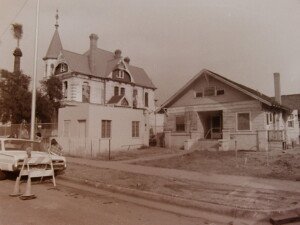
This house (built in 1911 and known as the Jones House) was removed during restoration of Heritage Square to make room for the Burgess Carriage House (we currently haven’t been able to find the Carriage House on the census, but we’ll keep looking!). In 1950, this house was divided into four separate apartments:
Apartment 1:
-
- Hazel Buttrick, head of household, white, age 63, married, born in Nebraska, kept house
- John Buttrick, son, white, age 17, single, born in Arizona
- Carol Thigpen, daughter, white, age 29, divorced, born in Iowa, secretary at a veterans’ hospital – lived in Maricopa county in 1949 but not in same house, parents were born in the US, finished high school, income in 1949 was $2400, not a veteran
- Daniel Thigpen, grandson, white, age 6, single, born in Arizona
Apartment 2:
-
- Theresa A. Kunze, head of household, white, age 23, single, born in North Dakota, registered nurse at a hospital
- Catherine M. Polaske, partner, white, age 27, single, born in Wisconsin, comptometer (mechanical calculator) operator for a telephone company
Apartment 3:
-
- George J. Tardif, head of household, white, age 67, married, born in Michigan, waiter at a night club – lived in a different county in 1949 (not listed), parents were born in Canada, finished 3rd grade, attended school that year, income in 1949 was $600, not a veteran
- Mary M. Tardif, wife, white, age 63, married, born in Illinois, kept house
Apartment 4:
-
- Mercedes B. Lennox, head of household, white, age 55, widowed, born in Spain, naturalized citizen, attendance officer at an elementary school
-
-
Who lived at the Duplex?
 North Duplex (City of Phoenix Parks office)
North Duplex (City of Phoenix Parks office)-
- Opal Funk, head of household, white, age 44, divorced, born in West Virginia, kept house
- Betty K Heflin, daughter, white, age 23, single, born in Arizona, office clerk with telephone company
- Jaye Funk, daughter, white, age 15, single, born in California
South Duplex (Heritage Square Foundation office)
-
- William P. Corkins, head of household, white, age 53, married, born in Indiana, film projectionist at a movie theater – lived in Maricopa county in 1949 but not in the same house, parents were born in the US, finished 6th grade, had attended school in the previous year, income in 1949 was $4300, was a veteran of World War I
- Gertrude M. Corkins, wife, white, age 47, married, born in West Virginia, kept house
- George W. Corkins, son, white, age 21, single, born in Indiana, sign painter with a painting contractor
- Sue M. Corkins, daughter, white, age 14, single, born in Indiana
-
-
Who lived at Stevens House?
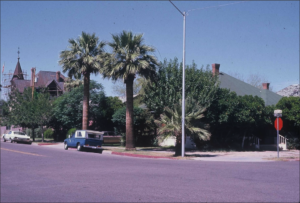 Frank E. L. Conter, head of household, white, age 25, married, born in Belguim [sic], naturalized citizen, “other” (frequently listed under “work” for students and those on sick leave)
Frank E. L. Conter, head of household, white, age 25, married, born in Belguim [sic], naturalized citizen, “other” (frequently listed under “work” for students and those on sick leave)- Lila L. Conter, wife, white, age 21, married, born in Arizona, kept house – lived in Maricopa county in 1949 but not in same house, parents were born in the US, attended college but hadn’t yet graduated, attended school that year, not a veteran
- Kenneth L. Conter, white, age 1, single, born in Arizona
- Thomas G. Patton, head of household, white, age 74, widowed, born in Texas, private practice attorney
- Dora Dillon, white, lodger, age 67, widowed, born in England, naturalized citizen, kept house
-
Who lived at Stevens-Haustgen House?
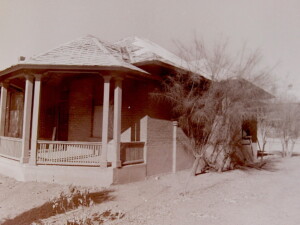 Margret [sic] Haustgen, head of household, white, age 79, single, born in France**
Margret [sic] Haustgen, head of household, white, age 79, single, born in France**- Fred G. Smith, lodger, white, age 43, married, born in Illinois, painter and carpenter – lived in Maricopa county in 1949 but not in same house, parents were born in the US, finished 11th grade, attended school that year, income in 1949 was $1200, not a veteran
- Della K. Smith, lodger, white, age 43, married, born in Oklahoma, kept house
By 1950, the person who had lived at Block 14/Heritage Square the longest (at least 30 years by that time) was Marguerite Haustgen. She owned and lived in what is now known as the Stevens-Haustgen House with her two lodgers. She also owned the Duplex and Stevens House, where her nephew, Frank Conter, lived with his family. Frank is also recorded living with Marguerite in the 1940 census; a niece, Mary Conter, is listed as living with her in the 1930 census; and Marguerite’s mother (Mary), her sister (Anna), and nephew (George Bernard) are recorded together along with two lodgers (John Powers and John McIver) in the 1920 census.
**Though the 1950 census lists Marguerite as being born in France, she’s listed as being born in Germany in the 1940 census, and in Luxembourg in the 1920 and 1930 censuses. And though she is recorded as not being a naturalized citizen here, the 1920 census says she did file papers to become naturalized.
-
Who lived at Teeter House?
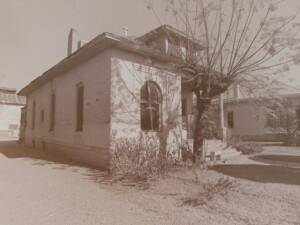 Alica [sic] Teeter, head of household, white, age 79, widowed, born in Kansas
Alica [sic] Teeter, head of household, white, age 79, widowed, born in Kansas- Molly B. Bowers, lodger, white, age 61, widowed, born in Texas, kept house – lived in Maricopa county in 1949 but not in same house, parents were born in the US, finished 8th grade, attended school that year, income in 1949 was $610, not a veteran
In 1911, recently widowed Eliza Teeter traded a farm near Tempe for this house and mule barn, and continued to use it as a rental property. She is listed in the 1930 census as living at the house with her daughter, Zella (one of her six children), and three lodgers (Dick Rumback, Edward Biggers, and Ralph Marks). In the 1940 census she’s listed there along with two lodgers (Alvin Rush and Katheryn Dillon).
-
Who lived at the Teeter Carriage House?
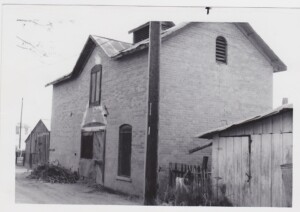 Melvin Pence, head of household, age 48, white, dishwasher at a restaurant
Melvin Pence, head of household, age 48, white, dishwasher at a restaurant
-
Who lived at Silva House?
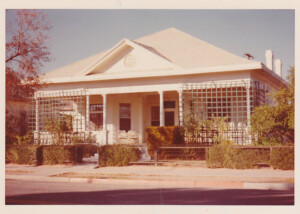 Frances B. Miramon, head of household, white, age 44, single, born in Arizona, kept house – lived in Maricopa county in 1949 in the same house, parents were born in the US, finished 8th grade (though it says in the 1930 census that she completed four years of high school), attended school that year, income in 1949 was $1000, not a veteran
Frances B. Miramon, head of household, white, age 44, single, born in Arizona, kept house – lived in Maricopa county in 1949 in the same house, parents were born in the US, finished 8th grade (though it says in the 1930 census that she completed four years of high school), attended school that year, income in 1949 was $1000, not a veteran- Mariam Sylva [sic], partner, white, age 39, single, born in California, kept house
Mary/Maria Silva moved to what’s now known as Silva House in 1926, the year after her husband, Alex/Alejandro, died. In the 1930 census, Mary lived there with her nieces, Marian Silva and Frances Miramon, and a servant listed as Valencia Juana. In 1950, Marian and Frances still lived in the House, and continued to live there together until Marion’s death in 1963. Frances sold Silva House to the City of Phoenix in 1977. Keep an eye out for a new exhibit about the Silva family, opening this year here at Heritage Square!
-
What other buildings were at the Square in 1950?
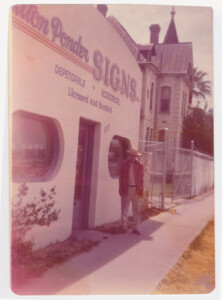 Along Monroe Street, east of Rosson House:
Along Monroe Street, east of Rosson House:-
- 615 Monroe St. (now the area behind Rosson House/part of the Lath Pavilion) – Sign Painting Shop (owned by Milt Ponder, who married Annie Gammel)
- 651 Monroe St. (now the Lath Pavilion) – Apostolic Temple
Along the south side of Adams Street:
-
- 637 E. Adams St. (gone)
- 625 E. Adams St. (gone)
- 623 E. Adams St. (now Pizzeria Bianco) – Autobody Shop
- 601 & 609 E. Adams St. (gone – now AZ Science Center) – Machine Shop and office
Though the Burgess Carriage House (Visitor Center) and the Thomas House (Bar Bianco) weren’t at Heritage Square in the 1950s, we decided to do a little more digging and look them up at their respective addresses. We haven’t yet found the Carriage House at their last address (130 E. Taylor St.), but we did find the Thomas House and the family who lived there during the 1950 census. They were:
-
- Daniel Grijalva, head of household, white, age 40, married, born in Arizona, elementary teacher at a public school
- Elizabeth, wife, white, age 31, married, born in Mexico, naturalized citizen, kept house
- Elizabeth Ana, daughter, white, age 9, single, born in Arizona
- Daniel P, Jr., son, white, age 2, single, born in Arizona
Daniel Sr. was a teacher at Lowell Elementary School for 37 years, and passed away in 1974. Elizabeth Sr. taught classes at the local nonprofit, Friendly House, to help new immigrants learn how to cook and keep house. She passed away in 1995.
-
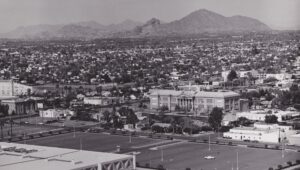 Learn more about who has and who hasn’t been counted in the US census (past and present) by reading Black Perspectives – A Compact for the Good of America? Slavery and the Three-Fifths Compromise, NPR – Your Body Being Used (prisons and the census), and Smithsonian Magazine – COVID-19 Adds a New Snag to the 2020 Census Count of Native Americans.
Learn more about who has and who hasn’t been counted in the US census (past and present) by reading Black Perspectives – A Compact for the Good of America? Slavery and the Three-Fifths Compromise, NPR – Your Body Being Used (prisons and the census), and Smithsonian Magazine – COVID-19 Adds a New Snag to the 2020 Census Count of Native Americans.
Much of the information for this article was found in the 1950 Census. If you decide to look up information in this census, we highly recommend using the1950 Census Enumeration District Finder website. It will make your census journey a little easier!
Other information was found online from the Heritage Square archives; Smithsonian Magazine – The First US Census Only Asked Six Questions; the Census Bureau (Historical Census Statistics, The “72 Year Rule”, Censuses of American Indians, and the 2020 Arizona Census); Ancestry – The Arizona Territorial Census; The Journal – The Census Hasn’t Always Counted Native Americans; Atlas Obscura – The College Student Who Decoded the Data Hidden in Inca Knots; and the Arizona Memory Project.
The map at the top of the page is a combination of pages 12 and 15 of the 1949 Sanborn Fire Insurance Map, centering Heritage Square in the middle. The picture of the Incan Khipu Knots is from Atlas Obscura. The picture of the 1950 census worker is from the Library of Congress.
Archive
-
2025
-
January (1)
-
-
2024
-
December (1)
-
November (1)
-
October (1)
-
September (1)
-
August (1)
-
July (1)
-
June (1)
-
May (1)
-
April (1)
-
March (1)
-
February (1)
-
January (1)
-
-
2023
-
December (1)
-
November (1)
-
October (1)
-
September (1)
-
August (1)
-
July (1)
-
June (1)
-
May (1)
-
April (1)
-
March (1)
-
February (1)
-
January (1)
-
-
2022
-
December (1)
-
November (1)
-
October (1)
-
September (1)
-
August (1)
-
July (1)
-
June (1)
-
May (1)
-
April (1)
-
-
2021
-
December (1)
-
November (1)
-
October (1)
-
September (1)
-
August (1)
-
July (1)
-
June (1)
-
May (1)
-
April (1)
-
March (1)
-
February (1)
-
January (1)
-
-
2020
-
December (1)
-
November (1)
-
October (1)
-
September (1)
-
August (1)
-
July (1)
-
June (1)
-
May (1)
-
April (1)
-
March (1)
-
February (1)
-
January (1)
-
-
2019
-
December (1)
-
November (1)
-
October (1)
-
September (1)
-
August (1)
-
July (1)
-
June (1)
-
May (1)
-
April (1)
-
March (1)
-
February (1)
-
January (1)
-
-
2018
-
December (1)
-
November (1)
-
October (1)
-
September (1)
-
August (1)
-
July (1)
-
May (1)
-
April (1)
-
March (1)
-
February (1)
-
January (1)
-
-
2017
-
December (1)
-
November (1)
-
October (1)
-
September (1)
-
August (1)
-
July (1)
-
June (1)
-
May (1)
-
April (1)
-
March (1)
-
February (1)
-
-
2016
-
December (1)
-
-
2015
-
2014
-
July (1)
-
